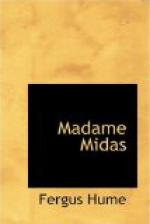outside the window and poured the poison into the glass
on the table. Mrs Villiers had stated that the
window was open all night, and from the position of
the table near it—nothing would be easier
than for anyone to introduce the poison into the glass
as asserted by Miss Marchurst. On the other hand,
the evidence of the detective Kilsip went to show
that no marks were visible as to anyone having been
at the window; and another thing which rendered Miss
Marchurst’s story doubtful was the resemblance
it had to a drama in which she had frequently acted,
called ‘The Hidden Hand’. In the
last act of that drama poison was administered to one
of the characters in precisely the same manner, and
though of course such a thing might happen in real
life, still in this case it was a highly suspicious
circumstance that a woman like Miss Marchurst, who
had frequently acted in the drama, should see the
same thing actually occur off the stage. Rejecting,
then, as improbable the story of the hidden hand,
seeing that the evidence was strongly against it, the
next thing was to look into Miss Marchurst’s
past life and see if she had any motive for committing
the crime. Before doing so, however, he would
point out to them that Miss Marchurst was the only
person in the room when the crime was committed.
The window in her own room and one of the windows
in Mrs Villiers’ room were both locked, and
the open window had a table in front of it, so that
anyone entering would very probably knock it over,
and thus awaken the sleepers. On the other hand,
no one could have entered in at the door, because
they would not have had time to escape before the
crime was discovered. So it was clearly shown
that Miss Marchurst must have been alone in the room
when the crime was committed. Now to look into
her past life—it was certainly not a very
creditable one. M. Vandeloup had sworn that she
had been his mistress for over a year, and had taken
the poison manufactured by himself out of his private
desk. Regarding M. Vandeloup’s motives in
preparing such a poison he could say nothing.
Of course, he probably did it by way of experiment
to find out if this colonial grown hemlock possessed
the same poisonous qualities as it did in the old
world. It was a careless thing of him, however,
to leave it in his desk, where it could be obtained,
for all such dangerous matters should be kept under
lock and key. To go back, however, to Miss Marchurst.
It had been proved by M. Vandeloup that she was his
mistress, and that they quarrelled. She produced
this poison, and said she would kill herself.
M. Vandeloup persuaded her to abandon the idea, and
she subsequently left him, taking the poison with
her. She then went on the stage, and subsequently
left it in order to live with Mrs Villiers as her
companion. All this time she still had the poison,
and in order to prevent her losing it she put half
of it into another bottle. Now this looked very
suspicious, as, if she had not intended to use it




